Publication of the Physics Laboratory in the Journal of Fluid Mechanics on September 14, 2022. CNRS-INSIS communication on September 30, 2022.
In a flow, the transport of particles or micro-organisms can be modified if they are attracted to areas rich in salts or nutrients. Researchers from the Fluid Mechanics and Acoustics Laboratory (LMFA, CNRS/École Centrale de Lyon/INSA Lyon/Université Claude Bernard Lyon 1), the Physics Laboratory (LPENSL, CNRS/ENS de Lyon) and the Camille Jordan Institute ((ICJ, CNRS/École Centrale de Lyon/INSA Lyon/Université Claude Bernard Lyon 1/Université Jean Monnet) have discovered a counter-intuitive behavior of these entities. The most mobile of them can be paradoxically blocked while the less active would go faster.
Abstract
In this article, we study numerically the dispersion of colloids in a two-dimensional cellular flow in the presence of an imposed mean salt gradient. Owing to the additional scalar, the colloids do not follow exactly the Eulerian flow field, but have a (small) extra-velocity proportional to the salt gradient, vdp=α∇S, where α is the phoretic constant and S the salt concentration. We study the demixing of an homogenous distribution of colloids and how their long-term mean velocity Vm and effective diffusivity Deff are influenced by the phoretic drift. We observe two regimes of colloids dynamics depending on a blockage criterion R=αGL/√4DcDs, where G is the mean salt gradient amplitude, L the length scale of the flow and Dc and Ds the molecular diffusivities of colloids and salt. When R<1, the mean velocity is strongly enhanced with Vm ∝ αG√Pes, Pes being the salt Péclet number. When R>1, the compressibility effect due to the phoretic drift is so strong that a depletion of colloids occurs along the separatrices inhibiting cell-to-cell transport.

Credits: Volk et al.
Reference: Phoresis in cellular flows: from enhanced dispersion to blockage. Romain Volk, Michaël Bourgoin, Charles-Édouard Bréhier and Florence Raynal. Journal of Fluid Mechanics, September 14, 2022.
DOI: 10.1017/jfm.2022.730






